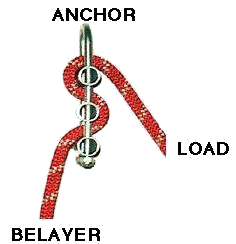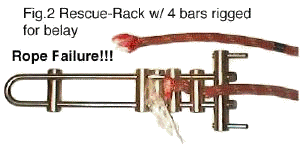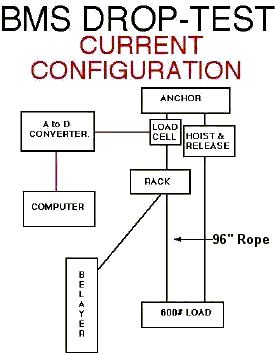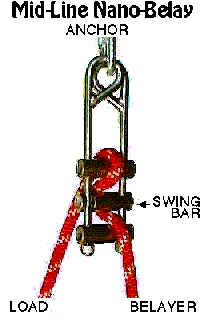Some Thoughts on Using Rappel Racks as Belay Devices
(Presented to the Vertical & Rescue Sections, NSS 2000 Convention)By Carroll Bassett, NSS #34462
Over the period of the last year we have been investigating the use of closed frame racks as belay devices for technical rope rescue. Since open frame racks can permanently deform under loads as low as 1000 lbs. we chose not to test this concept on them and believe that there may be a significant safety risk in using this form of rack for belays. Further work needs to be done in this area.
The original idea came from the realization that if a rack is rigged upside down a load would tend to squeeze the bars together generating friction in proportion to the load applied. This "self compensating" action was recognized during the development of our personal escape decent control devices, the Nano and Pico-Racks.
Our initial tests proved that the concept worked extremely well in that a dropped 600 lb. load could be successfully arrested with acceptable slippage of rope through the device (see fig. 1).
|
BMS Nano-Rack in
Belay Configuration  Figure 1 |
Encouraged by these results and wishing to eliminate the need to feed an end of a rope through the rack we experimented with rigging 4 bars of one of our Rescue-Racks (see fig. 2). By adding a fourth bar to the configuration we introduced much too much friction to the system which did not allow for the necessary rope slippage to dissipate some of the energy generated in the drop.
In our extensive test program this is the only failure we have witnessed. Using four bars in this "belay configuration" does not work and is extremely dangerous!

Returning to the initial tests, rigging 3 bars, we obtained, through a generous loan from Loui Clem, a high speed (1,000 samples / sec.) digital force measuring system, enabling us to accurately measure the forces acting on our anchor point (see fig. 3).
 Figure 3 |
With the installation of the load cells and some minor structural changes to our drop tower, we were able to add to our previous rope length of 72 inches another 24 inches of rope, 96 inches, bringing it a little closer to the standard of 3 meters (118.1 inches) suggested by Arnor Larson of the British Columbia Council of Technical Rescue (BCCTR) in his Aug. 2, 1990 paper, "Rescue Systems Testing". This test also calls for the maximum force transmitted through the system to the anchor point to be no greater than 15 kN (3,375 lbf.) We again used our 600 lb drop weight on all the 1/2 (12.5 mm) inch rope tests and constructed an additional 300 lb weight for the tests involving 7/16" (11 mm) rope . These loads and ropes correspond to NFPA specified one ("P") and two ("G") person use. The BCCTR calls for a 200 kg (440 lbs.) load for two person loads as well as a maximum rope slippage of 1 meter (39.3 in.) As in our previous tests the drop weight was raised a distance of 36 inches and released. Our test is some what more demanding of a belay device in that our fall factor (ratio of drop distance to rope length) is .375 as opposed to .333 for the BCCTR test and our drop weight is 160 lbs. heavier.
As you will see , most of these tests were carried out in the "Whistle Test" mode which leaves the rope usually held in a belayers hand unattended when the load is released. The "Belayed" test involved holding the rope in one gloved hand when the load was released. Each test was carried out in a series of three drops after which the rope was changed. The rope was not advanced during these three drops to see the effect of repeated "drops" on the same area of rope. With the exception of the 4 bar test, rope damage was minimal involving some glazing and minor sheath damage. We also employed an initial "half drop" to take out the slack in the bowline knot attaching the rope to the drop weight. This eliminates the shock absorbing effect of the knot and gives more of a worst case scenario to the test. We also did not employ a LRH (load releasing hitch) which also would have lowered peak anchor forces as it functions as a shock absorber. Special thanks to Kristin Pilotte for her invaluable help in compiling this data and to Steve Hudson of PMI for supplying the rope used in these tests.
|
ALL TESTS FALL FACTOR .375 (3 ft. drop on 8 ft. rope) "WHISTLE TEST" MODE Using a BMS NANO-RACK | ||
| DROP # | ROPE SLIP | MAX. ANCHOR FORCE |
| | | |
| | | |
|
|
|
|
| Using a BMS RESCUE-RACK | ||
|
| | |
|
| | < |
|
| | |
| Using a BMS MICRO-RACK | ||
| | ||
|
| | |
|
| | |
|
WHISTLE TEST" MODE USING 7/16" PMI EZ BEND WITH 300 LB. DROP WEIGHT Using a BMS NANO-RACK | ||
|
| | |
|
| | |
|
| | |
| Using a BMS MICRO-RACK | ||
|
| | |
|
| | |
|
| | |
|
"WHISTLE TEST" MODE USING 7/16 PMI IMPACT WITH 300 LB. DROP WEIGHT Using a BMS NANO-RACK | ||
| DROP # | ROPE SLIP | MAX. ANCHOR FORCE |
|
| | |
|
| | |
|
| | |
|
BELAYED MODE USING 1/2" PMI EZ BEND WITH 600 LB. DROP WEIGHT Using a BMS NANO- RACK | ||
|
| | |
|
| | |
|
| | |
A recent modification, suggested by John Kerr, to the Nano-Rack eliminates the Nano's limitation of not being able to be rigged in the middle of a rope (see fig. 4). To accomplish this the second bar of the Nano is replaced with an openable bar (swing) and the frame has been modified to allow the rope to pass inside the frame at the attachment point. This configuration is identical functionally with the belay configuration used on the Micro-Rack and will yield the same results. The price of this modification to allow midline placement, is that the belayer must be more attentive to the possibility of the second bar opening during operation. This in effect would render the belay ineffective. This should also taken into consideration when using a regular closed frame rack for a belay. To remedy this situation BMS has devised a spring latch for the second bar making it much less likely to open inadvertantly.
 Figure 4 |
Users of these belay devices should make their choices between the two carefully. If the ability to be placed midline is a prime consideration users must be vigilant not to allow the rope to become disengaged as above. A careful assessment of a teams skills and requirements will be helpful in making this decision.
With the conclusion of this series of tests, we believe that this technique offers rescuers a viable option over prussik knot belays . These rack belays eliminate three of the common problems found with the use of prussikms:
- Speed in rigging. Can be rigged in less than half the time required for tandem prussiks.
- Proper knot dressing. Often not dressed tight enough by inexperienced or occasional users.
- Compatibility of prussik cord with rope. Stiffer or larger diameter cords can allow excessive slippage especially when combined with 2.
Additional advantages include, less damage to ropes, thus providing greater margins of safety, and simplicity in rigging.
As with the tandem prussik belay, a load releasing hitch should be added to the system to enable the transfer of weight in the event of a "lockup". This can happen with inexperienced belayers or of course with a failure of the haul or lower system. Not including this component will necessitate higher skill levels of operators or the repair of the failed system before lowering or raising proceeds.
All of these tests were performed on BMS closed frame racks equipped with tubular stainless steel bars. We have no experience with other manufacturers equipment and as such cannot recommend the use of these techniques with their equipment.
Comments on the above will be appreciated and can be made to:
|
Carroll C. Bassett BMS, HC68 Box 64B, Friars Hill, WV 24938 304-497-4311 www.bmsrescue.com omc01207@mail.wvnet.edu |
Return to the Top of the Page
Return to the NH #46 Contents Page
Copyright © 2001 Vertical Section of the NSS, Inc. - All Rights Reserved.